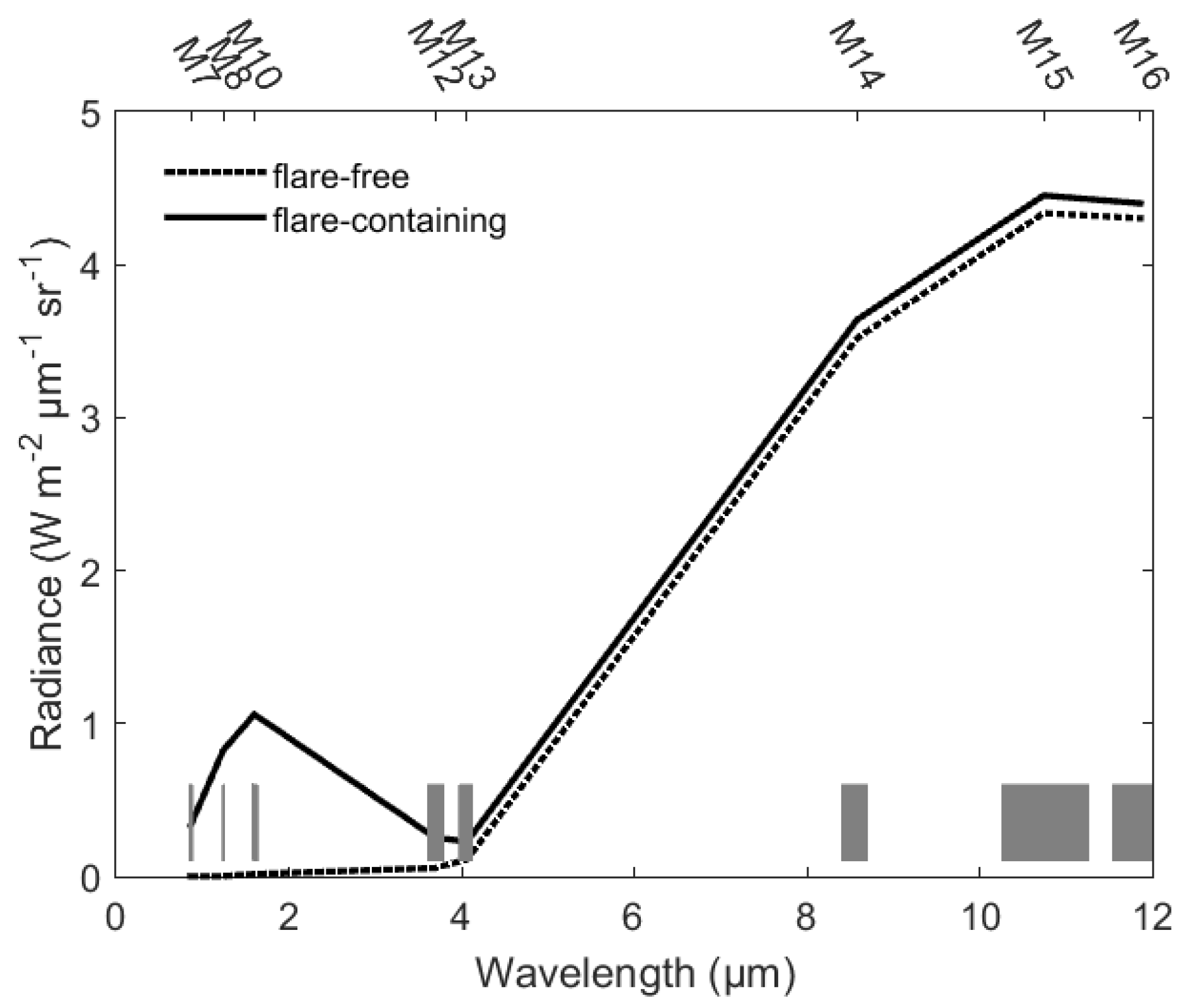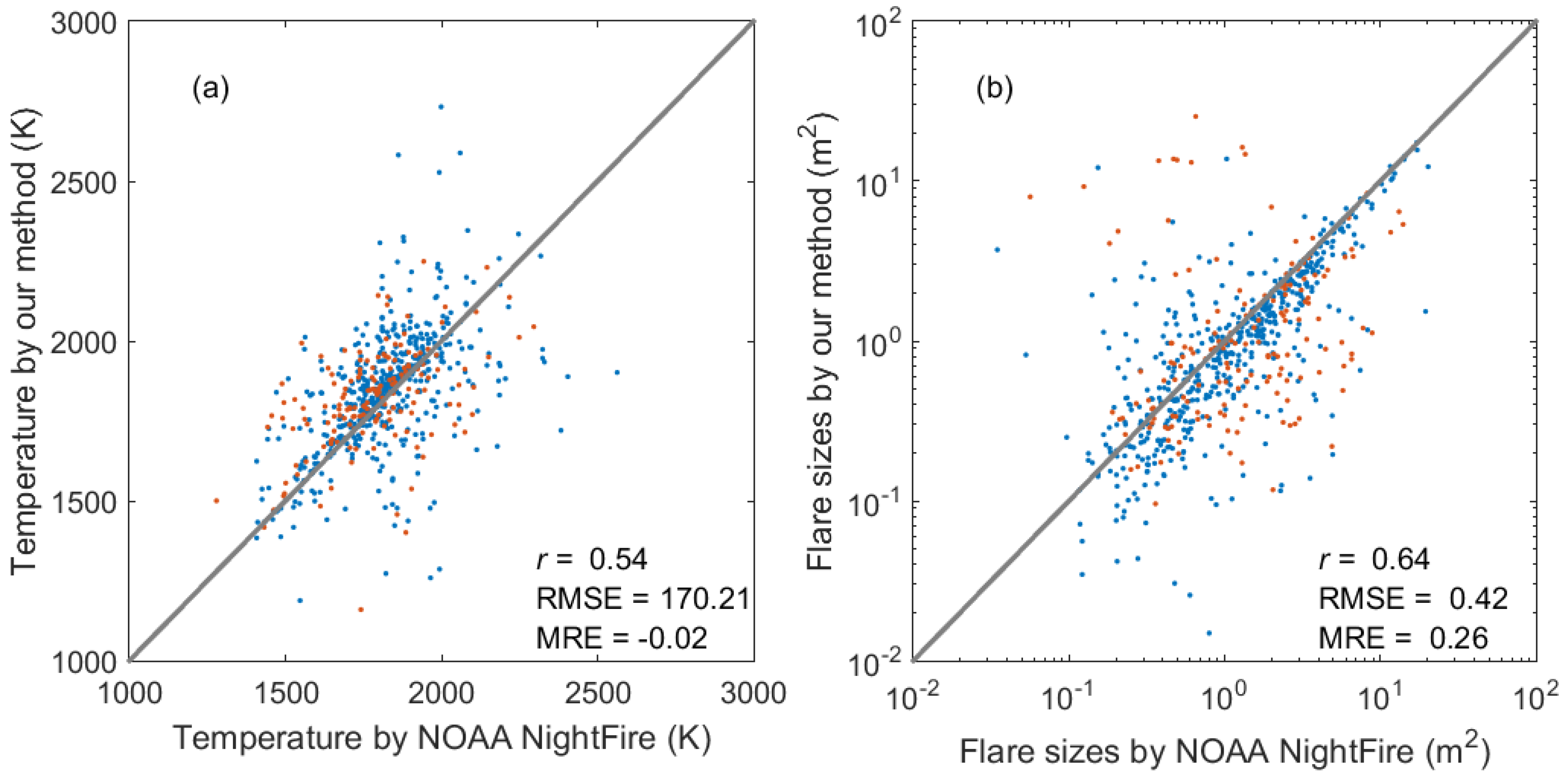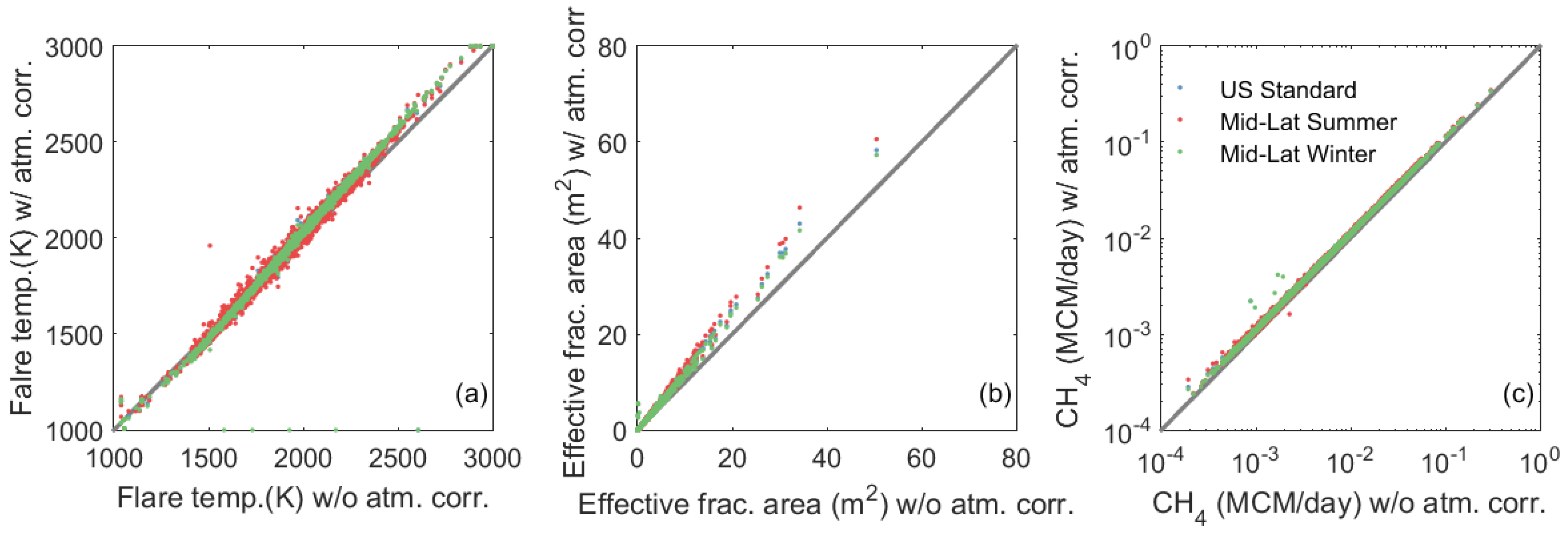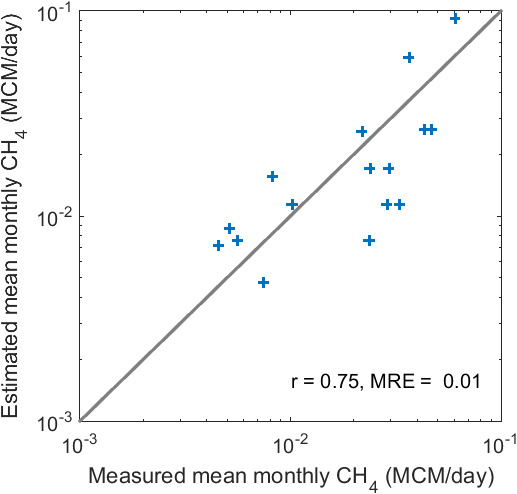1. Introduction
Flaring is a routine practice in the petroleum industry for the disposal of a large quantity of flammable gases and vapors that cannot be utilized or stored immediately. In 2013, about 7.4 × 10
9 m
3 of natural gas are burned in the U.S. often due to processing upsets or constraints in infrastructure for transmission and storage. This represents not only a significant waste of natural resources, but also emissions of CO
2, which can contribute to global greenhouse gas accumulations [
1]. To better understand the environmental impact of natural gas flaring, regular monitoring of flares and quantification of the amount of gas consumption and associated CO
2 footprint is required [
2,
3].
Satellite remote sensing has been used to study active fire since the 1980s (e.g., [
4]). Like typical biomass burning, flares are sub-pixel objects seen by a medium-resolution remote sensing sensor, the data of which typically is freely accessible to the public. Dozier [
5] demonstrated the detection of a sub-pixel hot source and its characterization in terms of temperature and area from nighttime remote sensing data at two infrared wavelengths, between which there exists a significant contrast in the thermal radiation by the hot target. The technique has been applied to detect fires and to determine the subpixel size of the active fire(s) and average fire temperature using the Visible Atmospheric Sounder (VAS) sensor on the Geostationary Orbiting Environmental Satellite (GOES) [
6,
7], the NOAA Advanced Very High Resolution radiometer (AVHRR) sensors [
8,
9], the Visible and Infrared Spectrometer (VIRS) on the Topical Rainfall Measuring Mission (TRMM) [
10], the Moderate-Resolution Imaging Spectroradiometer (MODIS) sensors [
11,
12] and the Visible Infrared Imaging Radiometer Suite (VIIRS) on the Suomi National Polar-orbiting Partnership satellite [
13]. Through a sensitivity analysis, Giglio and Kendall [
14] found that systematic retrieval errors can become enormous when the size fraction of the active fire is <0.005. A gas flare, typically of a size of <10 × 10 m
2 [
15], occupies at most a fraction of 1 × 10
−4 within a medium-resolution pixel, typically of a size of approximately 1 × 1 km
2. In addition, the temperatures of gas flares (1500–3000 K) are typically much higher than the biomass fires (around 1000 ± 200 K or less) [
16,
17]. While the Dozier method has been used to quantify gas flares (e.g., [
8]), methodological improvement is needed to better constrain the retrieval of gas flares from remote sensing data.
Elvidge
et al. [
18] empirically related nighttime radiance collected by the Operational Linescan System (OLS) sensor with a single panchromatic spectral band from the Defense Meteorological Satellite Program (DMSP) to natural gas flaring. The VIIRS sensor, following the legacy of AVHRR and MODIS, offers 16 medium-resolution bands in the visible and infrared wavelengths between 0.4 and 12 μm [
19]. Utilizing additional bands offered by the VIIRS sensor, Elvidge
et al. [
17] recently developed a method estimating the source area and temperature of flares using VIIRS data at multiple infrared bands. The results of the Elvidge
et al. [
17] method have been extended to estimate the gas emission through flaring. However, these results on gas emission have not been validated. Through collaboration, we have collected a limited amount of publicly-available data on associated gas flaring rates in Bakken field. These field data allow us to develop and validate a VIIRS-based method estimating CH
4 consumption and CO
2 emission rates from gas flaring.
3. Results and Discussion
Figure 4 compares the temperatures (a) and effective areas (b) estimated for all of the flares that have been detected within 12 h by both the NOAA NightFire algorithm and our method between January 2013 and June 2014. For the NOAA data, we only used those with viewing angles <32° (
i.e., in aggregation Zone 1). The scatter of the comparison is expected because of the methodological differences in detecting the flares and estimating their temperatures between the two methods. The NOAA NightFire algorithm uses the spatial contrast to identify a flare, particularly at the band M10 (
i.e., M10 for a flare is higher than the values of its neighboring pixels), whereas our method used the spectral difference to identify a flare, for which the radiance at the band M10 is greater than the value at the band M12. This detection difference arises from the fact that the NOAA NightFire algorithm is designed for the more general purpose of detecting hot sources with a wide range in temperature, while our algorithm was designed specifically for detecting flares, whose temperatures vary in a relatively tighter range of 1500–3000 K [
16,
17] and for which the emittance at M10 is always greater than that at M12. In addition, the NOAA NightFire algorithm uses the bands M7, M8, M10, M12 and M13 for retrieval of flare temperature [
17], whereas our method used Bands M7, M8, M10, M12, M13, M14, M15 and M16 (see
Figure 2). For the background, the NOAA NightFire algorithm only removes the background signal from Bands M12 and M13, whereas our method accounted for the background over all of the bands using neighboring pixels (see Equation (4)). Furthermore, atmospheric correction is performed for the NightFire data, whereas our method has assumed that the atmospheric transmittance τ = 1. Despite these differences in methodology, the two methods agree with each other reasonably well in estimating the temperatures and the areas of flares. For temperature, there is no systematic bias (the mean relative error is almost zero) and an absolute difference (as measured by root mean square error) of about 170 K; for area, the absolute difference is <0.5 m
2, and the mean difference 26%. Furthermore, we did not find any significant difference in comparison between Versions 1 and 2 of the NOAA NightFire products.
Figure 4.
Comparison of the temperatures (a) and effective areas (b) estimated for the flares by the NOAA NightFire algorithm and our method. Also shown are the statistical evaluation of the comparison in terms of correlation coefficient (r), root mean square error (RMSE) and mean relative error (MRE). The blue dots are for NightFire V1 data and red dots V2.
Figure 4.
Comparison of the temperatures (a) and effective areas (b) estimated for the flares by the NOAA NightFire algorithm and our method. Also shown are the statistical evaluation of the comparison in terms of correlation coefficient (r), root mean square error (RMSE) and mean relative error (MRE). The blue dots are for NightFire V1 data and red dots V2.
However, the comparison will be worse if we include NOAA data with viewing angles >32° (i.e., in aggregation Zones 2 or 3). For example, r, RMSE and MRE would be 0.44, 202 and −0.02, respectively, for temperature comparison; and 0.55, 0.50 and 0.33, respectively, for area comparison. As discussed earlier, a flare only occupies a tiny fraction of a VIIRS pixel (<1/5000), and hence, its detection is very sensitive to contamination or deterioration of signals. The pixels located towards the edges of VIIRS imagery would have a lower signal-to-noise ratio, a larger footprint size and, hence, a smaller contribution by a flare to the signal, longer atmospheric attenuation of the signal and are subject to bowtie deletion, all of which could potentially affect the detection and characterization of flares.
The NOAA NightFire product and the results of this study that collocate with the field data within 800 m (approximately the size for one VIIRS pixel) are averaged into monthly values for comparison with the field data. Again, we only used NOAA data with viewing angles <32°.
Figure 5 shows the comparison for CH
4 consumption. There is a significant difference between the two versions of the NOAA NightFire estimates in CH
4 rates. For Version 1, the NOAA results underestimate the field data (MRE = −0.73) with a correlation coefficient of 0.37; for Version 2, the NOAA results overestimate the field data (MRE = 7.63) and
r = 0.26. On the other hand, our estimates show significant correlation with field data (
r = 0.75) with an underestimation of 50%. We need to point out that our method, due to its more stringent image selection scheme, results in only 16 matches with the monthly field data, whereas there were 57 matches between the NOAA NightFire results and the monthly field data. Among the 57 matches, 37 are from the Version 1 product and 20 from Version 2. For the total energy output of methane burning (
Eout in Equation (6)), we use methane’s lower heating value (LHV) of 802 (kJ/mol) [
24], whereas NOAA’s NightFire algorithm uses the higher heating value (HHV) of 889 (kJ/mol), which would lead to about 10% underestimates in CH
4 consumption if everything else is the same. We do not know whether and what values the NightFire algorithm uses for the other parameters (α, C and F in Equation (7)) in estimating CH
4 consumption. However, it is beyond the scope of this study to investigate the methodological details of the NOAA NightFire product on flaring.
Figure 5.
Comparison of methane consumed in million cubic meter per day (MCM/day) through flaring between field and remote sensing estimates. Also shown in the legend are the correlation coefficient (r) and mean relative error (MRE) between the satellite estimates and the field data. The grey line represents a 1:1 relationship.
Figure 5.
Comparison of methane consumed in million cubic meter per day (MCM/day) through flaring between field and remote sensing estimates. Also shown in the legend are the correlation coefficient (r) and mean relative error (MRE) between the satellite estimates and the field data. The grey line represents a 1:1 relationship.
With the current setup, our results are expected to underestimate the consumption rates for two reasons: (1) the atmospheric correction is not applied; and (2) the minimum value of α has been assumed. As mentioned above, we did not apply the atmospheric correction to the VIIRS data. To evaluate its effect on the retrieval of CH
4 consumption, we used the MODTRAN radiative transfer model to estimate the transmittance,
i.e., τ in Equation (5) for the VIIRS bands with three different atmospheric models: mid-latitude summer atmosphere, mid-latitude winter atmosphere and 1976 U.S. standard atmosphere. The first two atmospheric models generally apply to Bakken field, and the last model has been widely used in related studies [
14,
17]. Elvidge
et al. [
17] found that non-atmospherically-corrected estimates of temperature highly correlated with, yet on average underestimate, the atmospherically-corrected results, with an underestimation ranging from 0.1% to 4% for flare temperatures of 1500–2500 K. Underestimation of a similar magnitude was also reported by Giglio and Kendall [
14]. Our results (
Figure 6a) are generally consistent with these earlier studies. With atmospheric correction, the effective fractional areas estimated for the flares are greater than the estimates without atmospheric correction (
Figure 6b), also consistent with the results of Elvidge
et al. [
17]. Applying atmospheric correction, the estimates of CH
4 consumption would generally be 10% greater than the estimates without atmospheric correction (
Figure 6c). However, this difference cannot fully explain the underestimation of CH
4 consumption, which is on average 50% lower, when compared to the field data (
Figure 5).
We have assumed α = 1 in the estimation of CH4 consumption (Equation (7)), where α represents the ratio of flare area to the cross-section area of the flare that a satellite sensor sees. Its value varies with the shape of a flare, but is always greater than one. For example, if we set α = 2, our estimates would on average agree with the field data with an MRE = 1%; if we set α = 3, our estimates would on average overestimate the field data with an MRE = 51%.
Figure 6.
Effect of atmospheric correction (atm. corr.) on the estimates of flaring temperature (temp.) (a), effective fractional (frac.) area (b) and CH4 consumption (c). The grey line represents a 1:1 relationship. Three different atmospheric models available in MODTRAN have been tested: mid-latitude summer, mid-latitude winter and 1976 U.S. standard.
Figure 6.
Effect of atmospheric correction (atm. corr.) on the estimates of flaring temperature (temp.) (a), effective fractional (frac.) area (b) and CH4 consumption (c). The grey line represents a 1:1 relationship. Three different atmospheric models available in MODTRAN have been tested: mid-latitude summer, mid-latitude winter and 1976 U.S. standard.
The ratio of surface to cross-section areas α, combustion efficient
C and F-factor
F cannot be derived from remote sensing, and therefore, their values have to be assumed. Furthermore, all of these three parameters decrease with wind speeds. For α, the stronger the wind, the more surface is exposed to a satellite sensor, and hence, its value becomes lower. On the other hand, the higher the wind, the greater the surface area (
fe) of a flare would expose to a sensor from above. Therefore, the combined effect of wind on the value of α ×
fe is reduced compared to individual effects. For the F-factor (
F), both observation and the model show that its value decreases with wind speeds, and the value of
F for methane varies between 10% and 30% [
24]. The combustion efficiency (
C) is relatively insensitive to wind speeds, even though its value can be lower under high wind conditions [
26]. Since the estimate of gas flaring is proportional to
(Equation (7)), in which three parameters (α,
C and
F) decrease and
fe increases with wind speed, at least some the wind dependence is cancelled out. The exact impact of wind conditions on estimating gas consumption and emission needs to be investigated further. From our results, we did not find any significant co-variation between the estimates of CH
4 consumption and wind conditions (
r = −0.1) in this study (
Figure 7).
Figure 7.
The estimated daily CH4 consumption vs. the wind speeds.
Figure 7.
The estimated daily CH4 consumption vs. the wind speeds.
4. Conclusions
In this study, a model was developed to estimate methane consumption of gas flaring using VIIRS nighttime data. Our estimates in methane consumption compared reasonably well with limited field data, whereas the NOAA NightFire estimates showed underestimation with Version 1 and overestimation with Version 2 (
Figure 5). There are significant differences in methodology between the NOAA NightFire algorithm and our method. First, we applied a more stringent data screening filter, retaining only those images that are cloud free and in the middle portion of a scene. Because flares are an extremely small object within a pixel of the VIIRS sensor, any contamination due to cloud or deterioration of the flare signal recorded at a large viewing angle would directly affect the detection of flares. Additionally, the comparison on temperature and effective area of flares between the NightFire and our method did improve when the NightFire data with viewing angles >32° were excluded. Second, we adopted Giglio and Kendall’s [
14] method using neighboring pixel(s) as the background and the spectral radiance at eight bands (M7, M8, M10, M12, M13, M14, M15 and M16) to derive the thermal temperature and fractional area of a flare (Equation (5)). Third, the lower heating value for methane combustion was used for calculations of thermal emissions and emissivity, which is more appropriate than the higher heating value that the NOAA NightFire algorithm uses. Finally, efficiency factors were accounted for to provide greater accuracy in calculating completeness in combustion and conversion of total reaction energy into radiant energy that can be sensed by a satellite sensor (Equation (7)).
Remaining uncertainties include determining the exact value for α, relating the area of a flare to its cross-section area that a satellite sensor sees from above. This value depends on the shape of the flare, but might vary in a tight range between one and three, within which our results agreed with the field data within ±50%. Further improvement of the method employed in this work can be achieved by using atmospherically-corrected VIIRS nighttime data; however, the improvement in using atmospherically corrected data is limited because the major uncertainty remains estimating the form factor of the flares.
We have validated the results using the field data collected in Bakken field. However, we believe the method is applicable to detecting and quantifying gas flaring in general, with the only assumption being that there exist neighboring pixel(s) with similar land and atmospheric conditions. Even though it is not evaluated in this study, it is straightforward to estimate the emission of CO2 using Equation (8) through gas flaring, which is one of our planned future works in continuing this study.












